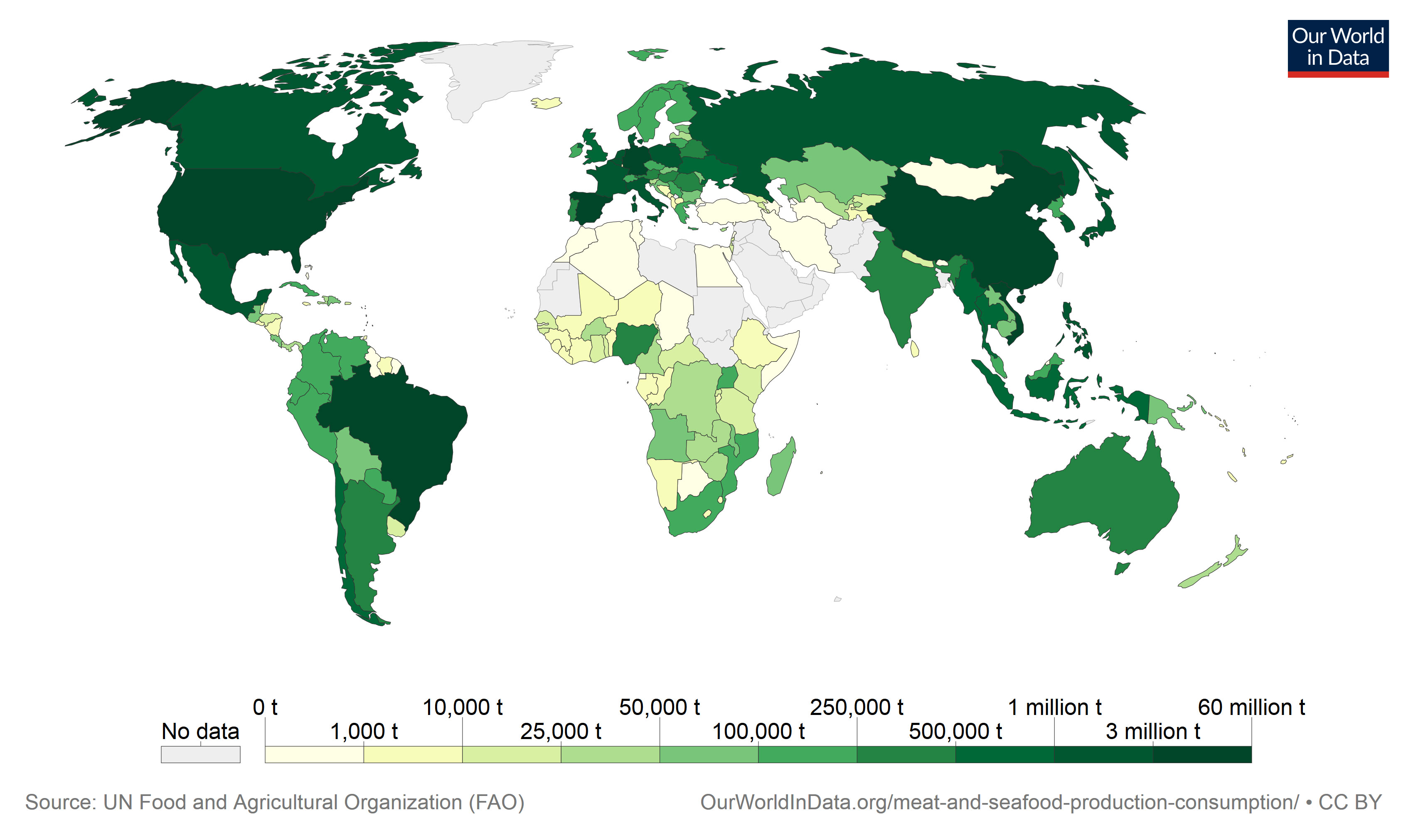Building our framework for the prevention and control of African swine fever (ASF)
On this page
- History
- Challenges to control
- Potential impact in the Americas
- Threats to the americas
- ASF Forum
- References
The African swine fever (ASF) virus is a large double stranded DNA enveloped virus of the Asfariviridae family. ASF is a haemorrhagic disease of all suids (domestic and wild pigs of the family Suidae).
ASF is a World Organisation for Animal Health (WOAH; founded as Office International des Épizooties (OIE)) listed disease which requires member countries to submit timely information on disease events to the WOAH.
History
- The disease was first recognized in Africa in the early 1900s, where it is maintained in African wild pigs (usually subclinically) with biological transmission by soft ticks.
- ASF virus reached Spain and Portugal early in the 1960s and subsequently spread to South America and some Caribbean countries. By the late 1990s ASF was eradicated from all of these regions. One exception is the Italian island of Sardinia where the disease entered in the late 1970s and is still endemic.
- Range expansion: ASF first appeared in the Republic of Georgia in 2007. Since then several European countries have reported ASF in domestic swine, wild boar, or both: Russia, Belarus, Ukraine, Moldova, and the EU countries Belgium, Bulgaria, Czech Republic, Estonia, Hungary, Italy (Sardinia), Latvia, Lithuania, Poland, and Romania.
- The disease was detected in China in August 2018, where it continues to spread, including into neighbouring Mongolia, Vietnam in February 2019 and Cambodia in April 2019. To date, China has reported ASF in both domestic swine and wild boar; Mongolia, Vietnam and Cambodia have reported the disease in domestic swine.
Challenges to control
- The ASF virus is able to survive for prolonged periods of time in animal products and the environment. ASF is contagious, and may be transmitted via direct contact between animals, contaminated feeds, infected ticks or from the environment. Additionally, there are no vaccines or treatments against ASF, which highlights the importance of preparedness activities, strict biosecurity, awareness, and prompt reporting of the disease in the prevention of ASF.
- The development of a vaccine against ASF has not been successful due to the nature of the viral infection, where the host's immune system is challenged in a variety of forms, and also due to some inherent characteristics of the virus.Footnote 1
- ASF appears to have become endemic in wild boar in the current outbreak occurring in Caucasus, Eastern and Western Europe. As described in the GF-TAD's handbook on ASF in Wild Boar, circulation of the virus in wild boar creates a self-sustained epidemiological cycle which makes controlling the disease even more challenging given its transboundary and multi-sectoral nature.Footnote 2
Potential impact in the Americas
The United States, Canada, and Brazil are amongst the world's top ten pork producing countries. An eventual incursion of ASF, with its potential associated disruption of supply chains and trade repercussions therefore represents a serious threat to the industry.
The United States is the world's third-largest producer and consumer of pork and pork products, with over 60,000 pig farms which produce over 22 billion pounds of pork yearly.Footnote 3 In recent years, the United States exports averaged over 25 percent of its commercial pork production.
Canada's pork industry contributes over 100,000 direct and indirect jobs, and generates approximately $24 billion to the Canadian economy. In 2017, Canada exported 1.2 million tonnes of pork to over 100 countries at a total value of $4 billion.Footnote 4
In Brazil, the pork industry is represented by tens of thousands of integrated producers, hundreds of processing companies and dozens of exporters. In 2015, Brazilian production reached 3.27 million tonnes, while exports totalled 450,000 tonnes, placing Brazil among the top four pork producers and exporters, along with China, the European Union and the United States.
In other parts of the Americas, Mexico posted the largest increase in pig inventory numbers in the world in 2017. Increased domestic consumption and favourable production conditions have led to a pork production forecast of 1.36 million tonnes in 2019.Footnote 5
Pork production figuresFootnote 6
Total pigmeat production measured in tonnes per year. All data shown relate to total meat production, that is, from both commercial and farm slaughter. Data are given in terms of dressed carcass weight, excuding offal and slaughter fats.

Pigmeat production, tonnes, 2013
Pigmeat production data is available in Comma Separated Values (CSV) file format and can be downloaded to sort, filter, and search information from the Our World in Data website.
Threats to the Americas
Pathways for introduction and spread of ASF
Legal commercial importation
Live pigs and pork products/by-products, feed ingredients of animal and non-animal origin, pet food and treats and veterinary biologics can be potential sources of ASF virus introduction.
The ever increasing global trade in animals and animal products poses a growing risk of exposure to transboundary animal disease agents in countries around the world. Recent outbreaks of ASF in Europe indicate that the highest preparedness levels may not be sufficient to prevent disease incursion (e.g., Belgium, Hungary). In the Americas, countries impose strict import controls, which can include prohibition of imports from countries or zones affected by ASF or time/temperature treatment requirements that reduce or eliminate the risk of virus introduction via legal importations.
Recently, attention has been directed at potential sources of introduction of the virus from non-traditional products, such as feed ingredients not of animal origin.Footnote 7 Evidence indicates that ASF virus can contaminate ingredients (or containers) and survive shipping. In addition to prevention of importation, many jurisdictions have legislation in place prohibiting the feeding of swill to pigs, therefore reducing exposure of swine to contaminated feed sources.
Legal travellers
Legal travellers may be a source of introduction of ASF through contaminated clothing or equipment or through illegal pork products for personal use. These products would need to be intentionally fed to pigs, or discarded in areas accessed by domestic or wild pigs. Insufficient information is available to assess the likelihood of this, although outbreaks of a variety of pig diseases around the world indicate that the movement of legal travellers is not an uncommon pathway of introduction of transboundary animal diseases into disease-free countries.
Other pathways
Wild pigs, transmission by competent ticks, international waste and illegal commercial shipments are other potential sources for the introduction of ASF. There are several historical and current outbreaks of ASF which have been directly linked to the dumping of international waste (e.g., Brazil, 1970s, Republic of Georgia, 2007). The importance of plans and procedures for proper handling and disposal of international waste cannot be overemphasized, particularly in the face of increased globalisation and travel patterns.Footnote 8
In a review of preventive measures aimed at minimizing the risk of ASF spread in pig farming systems, Bellini et al indicate that, given the stability of the ASF virus in the environment, drivers and their vehicles transporting pigs to pig holdings, market or slaughterhouse, delivering feed, or collecting carcasses represent a major risk for the transmission of the disease. Significant attention should be given to biosecurity practices, including cleaning and disinfection, during transportation events.Footnote 9
Illegal pathways
Agro-terrorism
Given the ASF virus characteristics of being contagious, economically devastating, environmentally stable and non-zoonotic, this virus has potential to be used in agro-terrorism activities.
Contraband
In March 2019, authorities in the United States seized a large shipment of smuggled pork meat at port in New Jersey. Given the current controls in place, it is unlikely that this meat would be fed to pigs. However, this illustrates that the illegal importation of animals and products provides a route by which safety controls would be bypassed. It is believed that the 2001 outbreak of Foot and Mouth Disease in Great Britain was a result of illegally imported meat that found its way into incompletely treated swill feed fed to pigs.Footnote 8 Accurate estimates of animal products illegally imported represent a challenge to generate.
ASF Forum
This backgrounder forms the context for the discussion at the ASF Forum in Ottawa on April 30-May 1, 2019. The objective of the ASF Forum is to advance regional cooperation in the prevention and mitigation of the impact of ASF in the Americas. Discussions will provide participants with an enhanced understanding of the important issues outlined above, allowing decision makers to focus their attention on regional collaborations to strengthen efforts to prevent and respond to an outbreak of ASF in the Americas.
